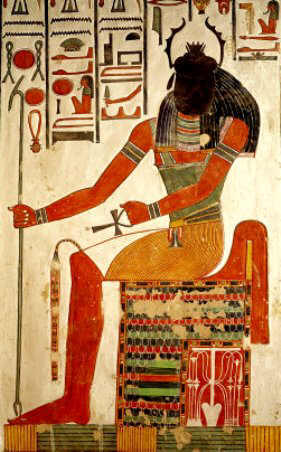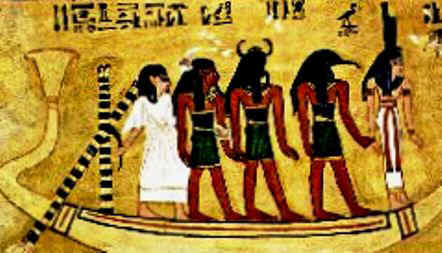
| The Scarab | 
|
|
Ancient Egyptian Gods and Goddesses for kids - The Scarab Symbol The history of ancient Egypt and the significance of the Scarab |
|
The Scarab
Discover the history and religious beliefs surrounding the Scarab Symbol which was one of the most important religious Egyptian Symbols in the mythology of ancient Egypt. The scarab beetle was also called the dung beetle because of its practice of rolling a ball of dung across the ground which it then used as a food source. The Scarab beetle symbolized the sun because the ancient Egyptians saw a likeness between the scarab beetle rolling the dung and the sun god rolling the sun, making it shine on Earth. In ancient Egyptian religion the scarab was also a symbol of immortality, resurrection, transformation and protection much used in funerary art. The life of the scarab beetle revolved around the dung balls that the beetles consumed, laid their eggs in, and fed their young represented a cycle of rebirth. When the eggs hatched the scarab beetle would seem to appear from nowhere, making it a symbol of spontaneous creation, resurrection, and transformation. A scarab amulet provided the wearer with protection and confidence in the certain knowledge of reincarnation. Khepri was the scarab headed god who represented the power of the scarab symbol. |
|
Facts about the ancient Egyptian Scarab Symbol
The Scarab beetle was a potent ancient Egyptian symbol and icon in the mythology and legends of Egypt. According to ancient Egyptian mythology the Scarab Symbol
The Scarab Fact File | 
|
| | Name: | The name of the common scarab beetle, or dung beetle, is the scarabaeus (Scarabaeus sacer). The word 'scarab' derives from the Latin word scarabaeus meaning "a type of beetle". It is also called the the dung beetle because of its practice of rolling a ball of dung across the ground.
| Description of
the scarab beetle: | The scarab beetle has a smooth black body that reaches 1.5 inches (4 cm in length). The appendages of the beetle are sharply serrated
| | Symbol: | The Scarab Symbol was one of the most potent symbols of ancient Egypt primarily symbolizing the sun, resurrection, transformation and protection
| | Heart Scarabs: | Scarab amulets (heart scarabs) were much larger than ordinary scarab amulets, and usually flanked with falcon’s wings, were often placed over the heart of mummies inscribed with a spell from the Book of the Dead which entreating the heart "do not stand as a witness against me."
| | Significance: | The sacred Scarab Symbol ensuring the deceased would be unafraid when the heart was weighed against the feather of truth during the ceremony of justification in the Hall of the Two Truths. The scarab aided its wearer with the power of "eternal renewal of life." |
|
|
Facts about the Scarab Symbol in Egyptian Mythology
Discover interesting information and research facts about the Scarab Symbol, the potent Egyptian symbol. The facts about the Scarab Symbol provides a list detailing fascinating additional info to increase your knowledge about the Scarab Symbol in Egyptian Mythology and history. 
Picture of Khepri, scarab headed god Facts about the Scarab from Mythology and Egyptian History |
Fact 1: |
A "scarabaeus" is now an outdated term for an object in the form of a scarab beetle in Egyptian art
| | Fact 2: | The heart scarab was placed in the tomb of the deceased in order to guide and protect them in the afterlife
| | Fact 3: | Millions of amulets were made in Egypt depicting the scarab beetle. Scarabs were used by both the rich and the poor. The scarab and Solar worship were inseparable in ancient Egypt
| | Fact 4: | The heart scarab was believed to secure exemption from the terrible consequences of leading an evil life. Ammit, the crocodile-headed goddess and "Devouress of the Dead", attended the Judging of the Dead and devoured those deemed to be sinners.
| | Fact 5: | The symbol of the scarab was also known as the Khepher
| | Fact 6: | Winged scarabs were designed to provide a safe journey into the Afterworld of the gods
| | Fact 7: | Scarab seals were commonly used in ancient Egypt. Scarab seals were quite small, generally less than none inch in length. The name of a particular person, pharaoh, or official title was inscribed on the flat base of a seal to ensure protective powers would be given to the owner and to the owner's property.
| | Fact 8: | The flat underside of scarabs, used as amulets, were usually inscribed with names, magical spells, images of deities, sacred animals and other religious symbols.
| | Fact 9: | The Egyptian name for the dung beetle was 'hpri' meaning "rising from, come into being itself, to change" became the divine name Khepri, given to the creation god, who represented the rising sun
| | Fact 10: | There were many different types of scarabs including ornamental scarabs, heart scarabs, scarab seals, winged scarabs, marriage scarabs, scarabs with spells, scarabs with good wishes and scarabs decorated with figures of gods and animals.
| Facts about the Scarab Symbol from Mythology and Egyptian History |
|
|
Bennu- Interesting research information and Facts about the ancient Egyptian Scarabs Symbol and symbolism
- The sacred bird of the ancient Egyptians
- Egyptian Mythology associated with Scarabs
- Facts and information about the gods and deities of of classical Egypt for schools, research and kids
- Pictures, Description and fact sheet on scarabs for kids
|
| | |
|

Scene from the Book of the Dead Picture of the Scarab headed god
The picture of the Scarab headed god Khepri, depicts a scene from the Book of the Dead and the imaginary journey of a scribe called Ani travelling on a bark through the Underworld: - The first figure shows Ani the scribe wearing the white tunic
- Ani stands behind the god Shu, identified by the feather headdress
- Khepri the scarab headed god
- Thoth, the ibis headed god, who was the god of wisdom and the secretary of Ra, the Supreme Solar God and scribe of the Underworld
- Isis, identified by her indicated by her 'throne style' crown
|
|
|
|
|